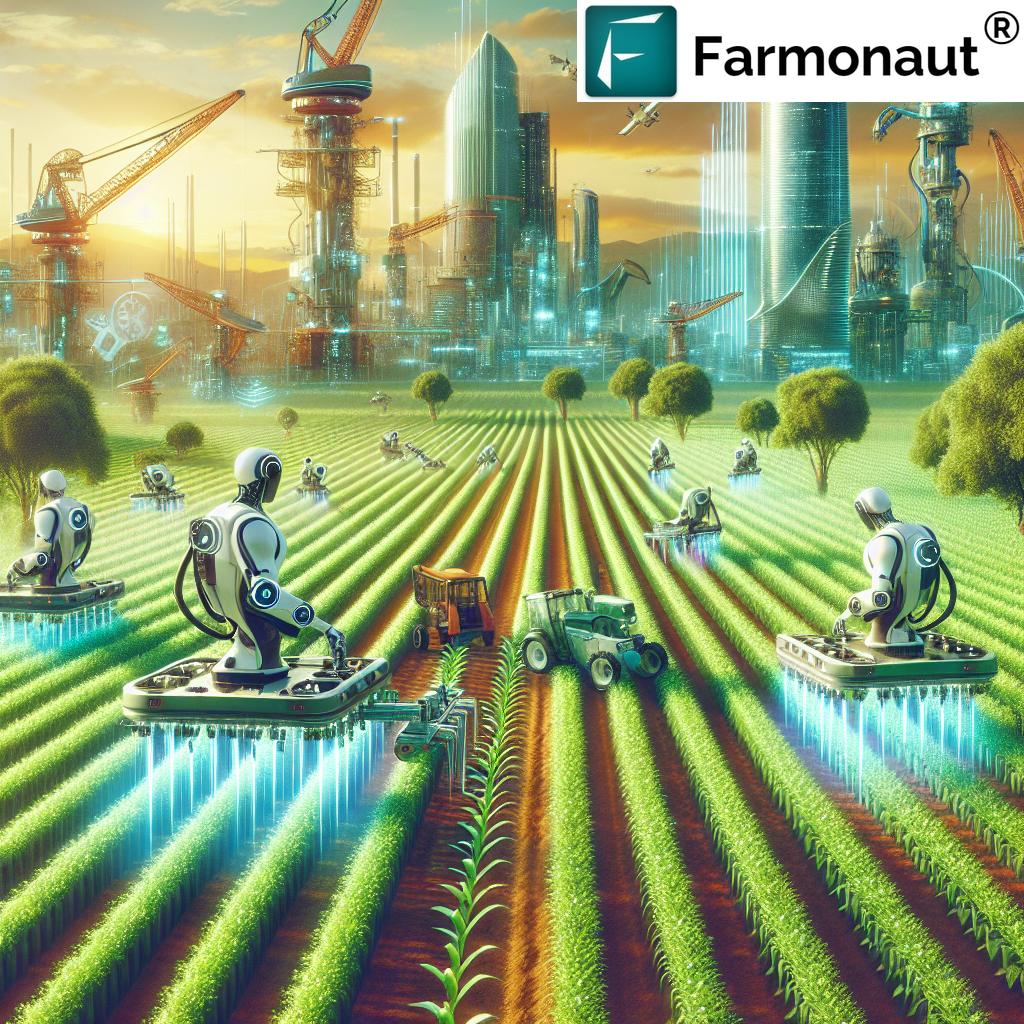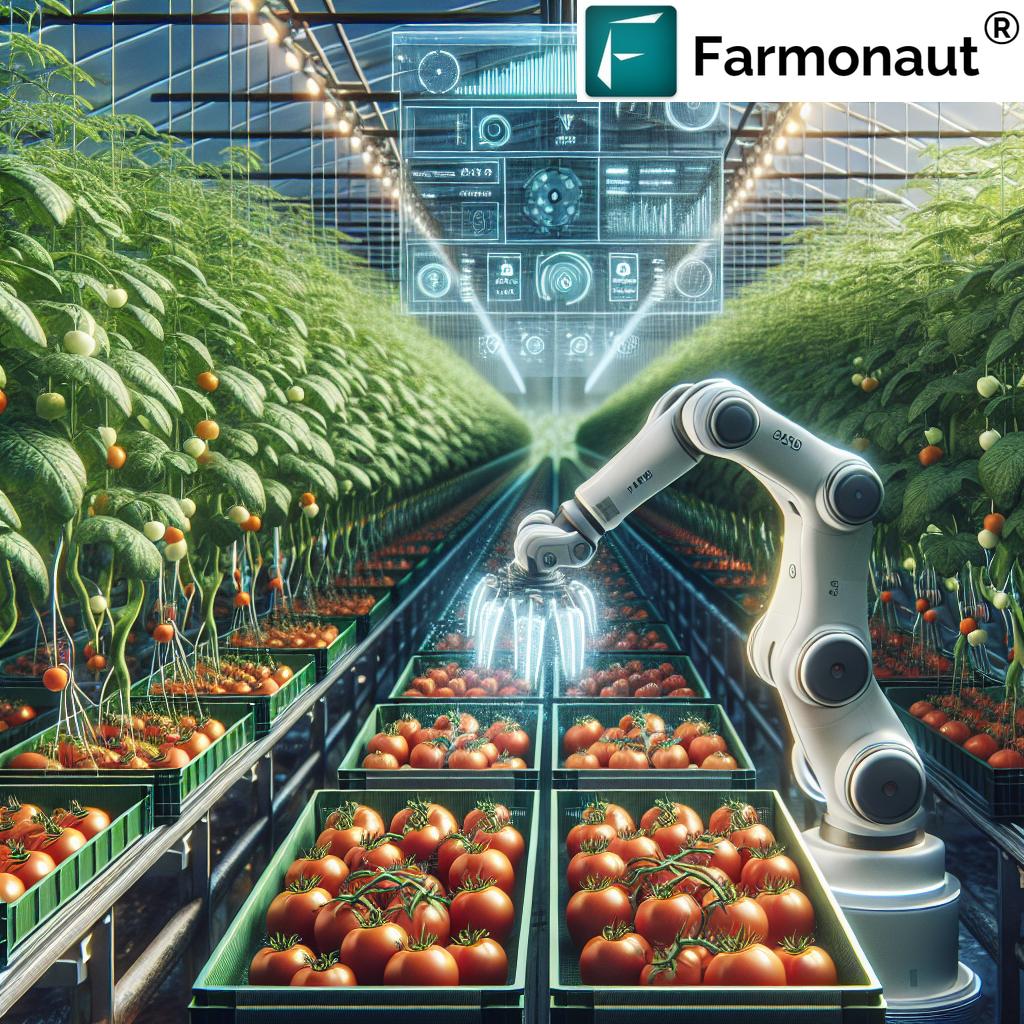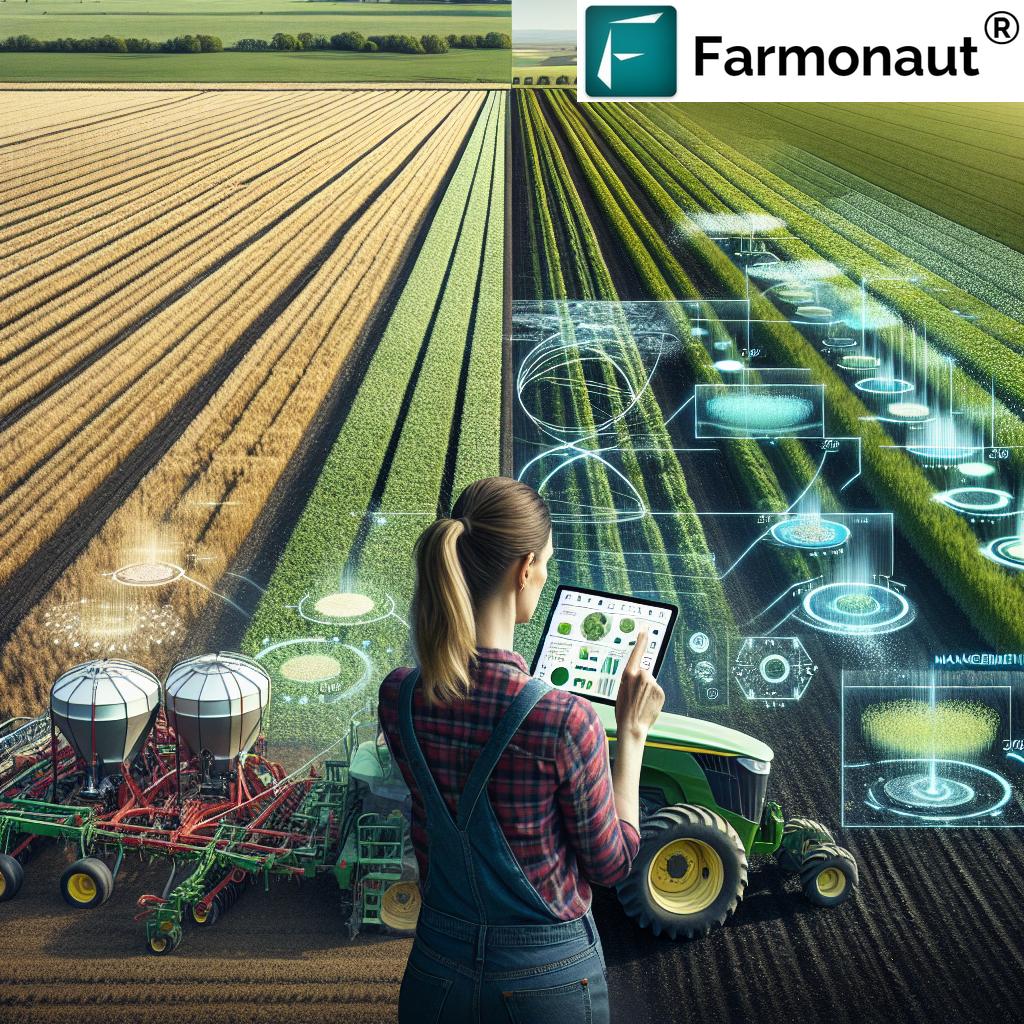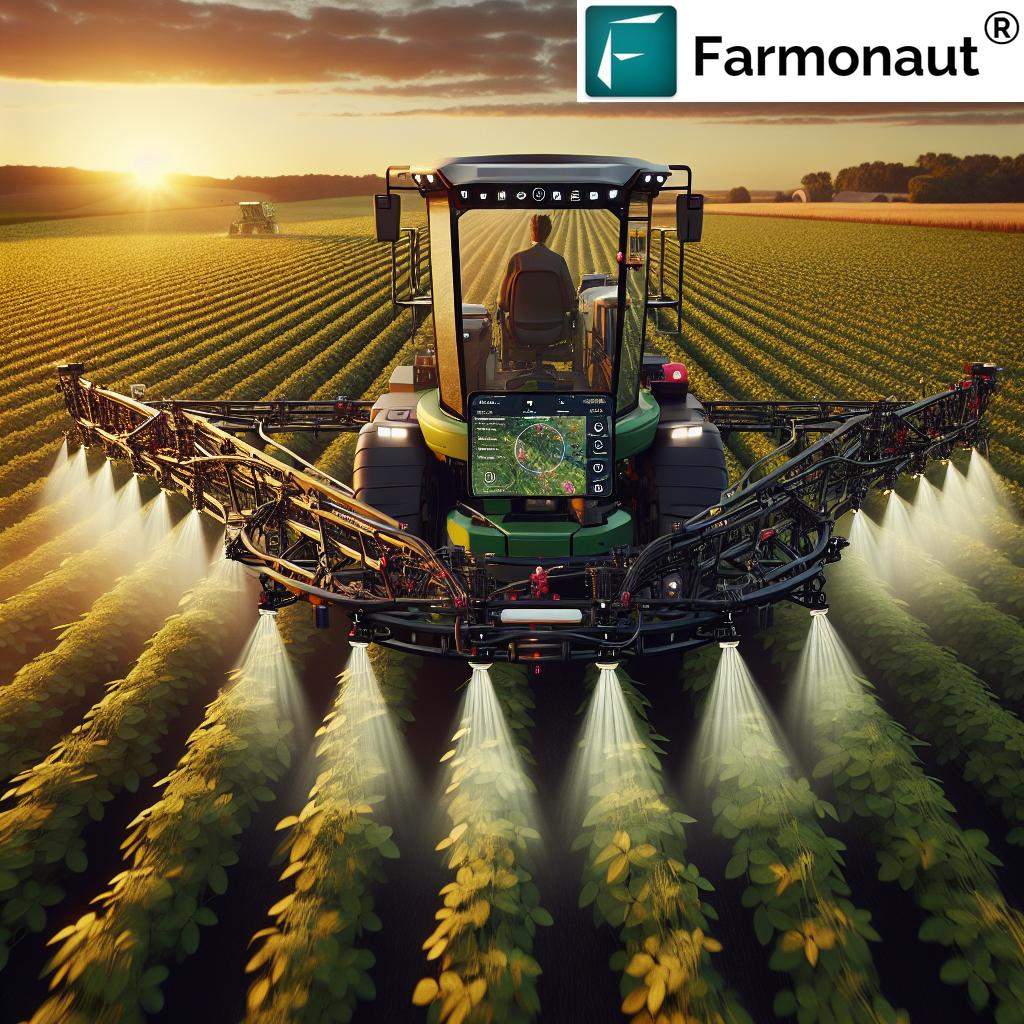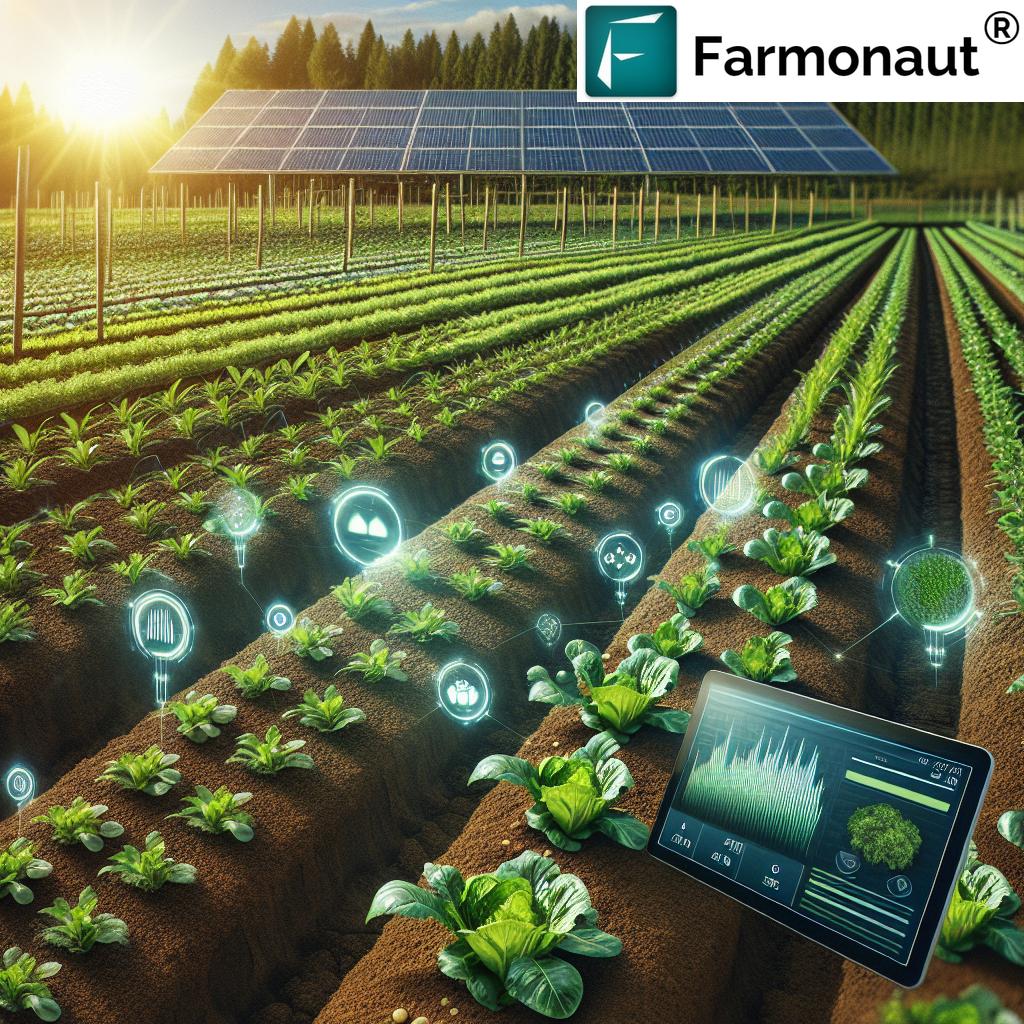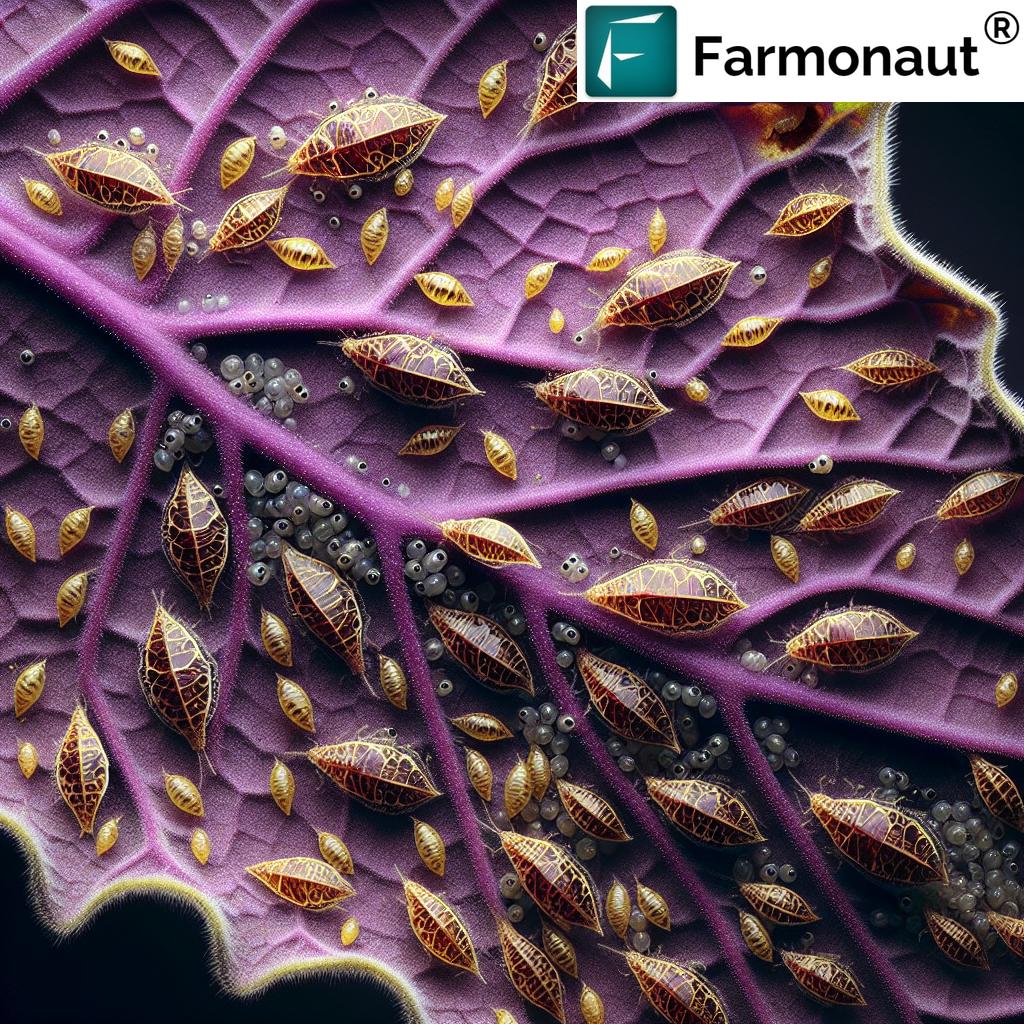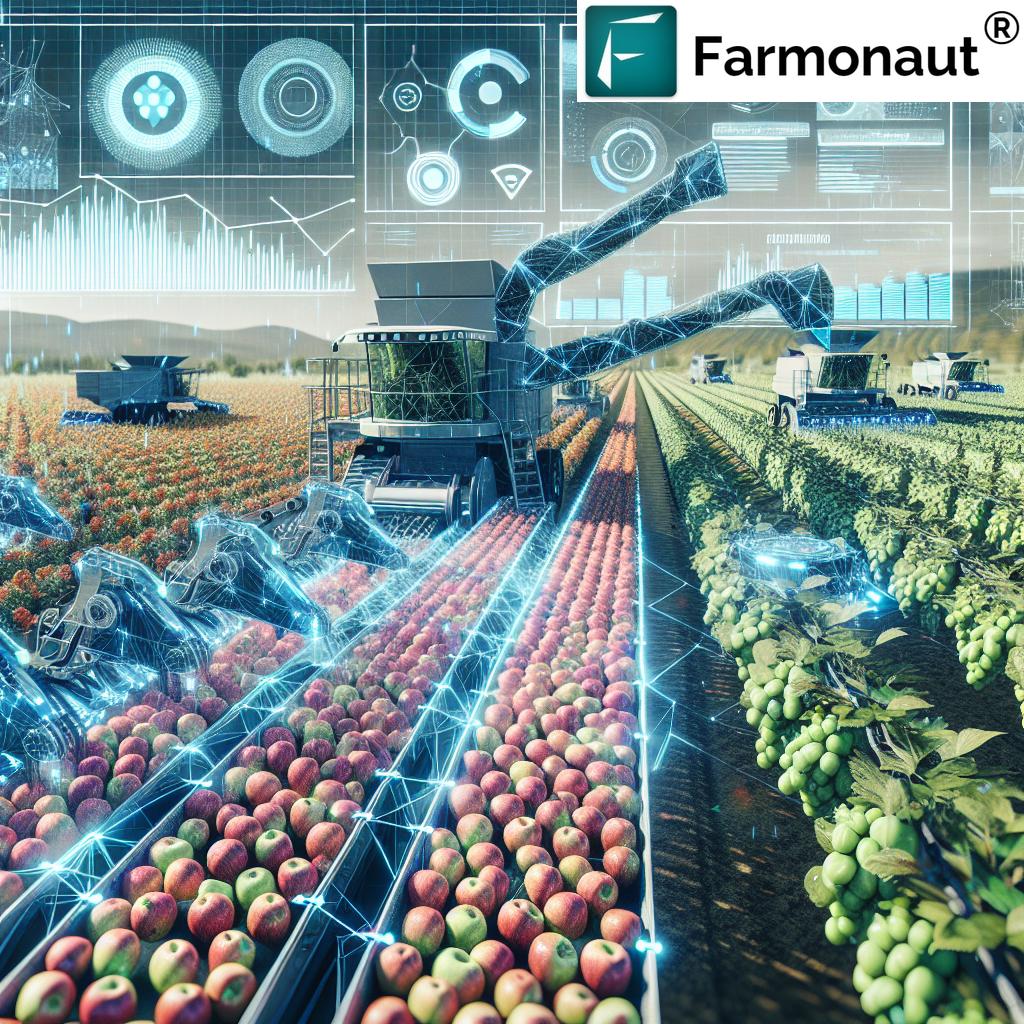Table of Contents
- Introduction to Robotic Farming
- The Benefits of Robotic Farming
- 7 Robotic Farming Secrets: Innovative Applications Transforming Yields
- Feature Impact Comparison: Robotic Technologies in Agriculture
- Farmonaut: Satellite-Powered Precision Agriculture Solutions
- Challenges and Considerations for Robotic Farming Adoption
- The Future of Robotic Farming and Precision Agriculture
- FAQ: Robotic Farming, Automation & the Next Generation of Agriculture
- Farmonaut Subscription Options
- Conclusion
“Robotic farming can increase crop yields by up to 20% through precise planting and harvesting techniques.”
Robotic Farming Secrets: 7 Ways Robots Transform Yields
Robotic farming, or agricultural robotics, is rapidly reshaping how we grow, manage, and harvest our food. By integrating robots, automation, and advanced technologies into traditional agricultural practices, we—farmers, agribusiness leaders, and innovators—are unlocking greater efficiency, productivity, and sustainability in our fields. The secret is out: robots in agriculture aren’t just replacing manual labor—they’re ushering in a new era of precision agriculture technologies that promise healthier crops, reduced costs, and a greener planet.
In this comprehensive guide, we’ll reveal the 7 most impactful ways robotic farming is transforming yields around the world. Along the way, we’ll explore how platforms like Farmonaut make precision agriculture accessible for farmers everywhere, leveraging the power of AI, machine learning, satellite imagery, and more. Join us as we dig into the technology, the benefits, the challenges, and the bright future of farming technology.
The Benefits of Robotic Farming
Why are more modern farms and agribusinesses embracing robotic farming and automation in farming? The benefits reach far and wide, revolutionizing core operations. Let’s break down the most impactful advantages:
- Increased Efficiency & Productivity: Robots execute repetitive or complex tasks—like planting seeds or harvesting crops—with a speed, precision, and consistency impossible for manual labor. This results in higher daily outputs and maximum use of windowed growing/harvesting seasons.
- Reduced Labor Costs: Automated systems and robotic machinery need minimal supervision, slashing workforce requirements and associated expenses—crucial as rural labor becomes scarce and expensive around the globe.
- Enhanced Sustainability: These systems allow the precise application of inputs like water, fertilizers, or chemical treatments, minimizing resource usage, waste, and environmental impact.
- Improved Crop Quality & Consistency: Robots identify, sort, and grade produce for consistent quality—reducing losses from manual errors and post-harvest spoilage.
- Data-Driven Agriculture: Advanced robotics collect and analyze field data—from soil conditions to crop health monitoring—for informed, real-time decisions that optimize every phase of farming.
“Automated tractors reduce labor costs by nearly 30%, revolutionizing efficiency in large-scale agricultural operations.”
7 Robotic Farming Secrets: Innovative Applications Transforming Yields
Let us unveil the seven ground-breaking applications where robots in agriculture are driving productivity, efficiency, and sustainability—right from the soil to final harvest.
1. Precision Agriculture and Robotic Crop Monitoring Systems
The core of modern precision agriculture technologies is real-time data collection—and robots do this better than anyone! Equipped with advanced sensors and cameras, robotic crop monitoring systems endlessly scan vast fields, gathering valuable information on:
- Soil conditions (nutrients, compaction, pH, organic matter)
- Moisture levels—both at surface and root depth
- Crop health and stress indicators (disease, pest infestations)
- Growth patterns and plant density
With this data, we optimize irrigation, time nutrient application, and detect issues early—enabling us to maximize yields while minimizing resource waste.
Discover how Farmonaut’s Crop Plantation Forest Advisory tools use satellite-based data for real-time crop diagnostics and AI-powered recommendations.
Farmonaut’s multispectral satellite-based crop health monitoring empowers us to act on NDVI (Normalized Difference Vegetation Index), soil moisture levels, and evolving crop conditions—delivering actionable AI-based insights instantly via web and mobile. Precision gains? Yields up, losses and resource waste down.
2. Robotic Weed Control & Smart Pest Management
Weeds and pests are major threats to crop health and yields, often demanding high doses of chemical herbicides and pesticides. With robotic weed control, AI-powered robots use computer vision to distinguish crops from weeds and identify pest infestations—then act with precise, targeted removal.
- Targeted action: Robots apply herbicides only to weed patches, or even mechanically uproot weeds, drastically reducing chemical usage and environmental impact.
- Cost savings: Farmers save on input costs, and avoid yield penalties from blanket spraying.
- Healthier soils: Less chemical runoff supports soil biodiversity and long-term sustainability.
These AI and machine vision-guided robotics extend beyond weed control. By scanning for early detection of diseases and infestations, they help us act before a threat spreads, keeping crops—and profits—healthy.
3. Robotic Harvesting Solutions & Post-Harvest Automation
Harvesting is physically demanding and time-sensitive, too often limited by labor availability and human error. With robotic harvesting solutions, autonomous machines step in to pick fruits, vegetables, and grains; sort and grade produce by size and quality; and even pack/palletize for market—all with relentless precision.
- Reduced production losses: Robots ensure consistent picking quality—less fruit is damaged or left on the plant.
- Improved consistency and traceability: Machines use vision systems to monitor produce and record real-time process data.
- Mitigate labor shortages: Robots offset the shrinking agricultural workforce.
Automated post-harvest processes—sorting, grading, packing—further reduce manual errors and maximize returns to farmers and processors, while blockchain-based traceability solutions (like Farmonaut’s Product Traceability module) record every movement for food safety and trust.
4. Robotic Planting & Seeding Precision Technologies
Planting—the foundation of yield—is now driven by autonomous seeders and planters. Modern robotic planting machines achieve millimeter accuracy in plunging seeds at optimal depth and spacing. Here’s how this robotic innovation transforms productivity:
- Less seed wastage: Robots calculate and deliver the exact number of seeds per row, per plot.
- Improved germination and plant health: Automated systems create ideal soil conditions for healthy root development across every square meter.
- Efficient hybridization: Specialized robots aid in cross-pollination and precision planting for hybrid seed production.
A standout in this space is the Farmdroid FD20, a fully autonomous field robot that can handle both precise seeding and mechanical weeding—amplifying labor and input savings. The bottom line: better stand establishment means healthier plants and higher yields.
5. Robotic Irrigation Systems & Waste-Free Nutrient Delivery
Water and fertilizer management are critical input challenges. Robotic irrigation systems offer site-specific and plant-specific delivery of water and nutrients. Robots equipped with sensors scan soil moisture in real-time; then, automation in farming triggers micro-irrigation or localized fertigation.
- Drip-by-drip efficiency: Water goes only to the root zone, slashing evaporation losses and runoff.
- Input reduction: Smart systems adjust the application of nutrients according to real-time crop needs.
- Increased yield and sustainability: More efficient water/nutrient use means healthier plants and less environmental impact.
Farmonaut’s satellite and AI-driven soil moisture mapping integrates with irrigation planning for farmers worldwide—enabling informed, cost-saving irrigation decisions. Explore Farmonaut’s carbon foot-printing tools to track and refine environmental impact as you modernize your irrigation.
6. Robotics in Livestock Management
It’s not just about crops. Robotics in agriculture is transforming livestock management too. Autonomous herding robots now use GPS and machine vision to monitor flocks, guide movement, and manage feeding or milking with minimal human intervention.
- Boosted productivity: Robots optimize feed schedules, automate cleaning, and even monitor animal health visually.
- Improved animal welfare: Consistent routines and reduced stress lead to higher milk, meat, or egg outputs.
- Precise traceability: Digital data tracks animals’ health, growth, and movement—essential for food safety and certification.
This automation in farming extends into fleet management, with platforms like Farmonaut’s Fleet Management tools for maximized vehicle uptime and lower fuel and maintenance costs. Whether for crops or herds, integration yields smarter, more sustainable farms.
7. Data Integration, Traceability, and Large-Scale Farm Management
The real genius of robotics in agriculture is found in data unification. From robotic sensors and drones to autonomous tractors, today’s smart farms rely on centralized, cloud-based systems that unite all disparate sources of data.
- End-to-end crop/livestock traceability: Blockchain and IoT ensure data security and transparency at every supply chain step. Farmonaut offers a robust blockchain-based traceability solution for complete product tracking and auditability.
- Large-scale efficiency: Farmers and agri-enterprises use Farmonaut’s AgroAdmin tools to manage dozens—or even thousands—of fields remotely, coordinate fleets, and automate reporting and analytics.
- Easy financing and insurance integration: With remote, satellite-based verification by Farmonaut, crop loans and insurance can be approved faster, with less fraud. Visit Farmonaut’s Crop Loan & Insurance solutions to streamline rural credit and risk management.
Unifying these new streams of robotic, satellite, and AI-driven data is the foundation for the future of farming technology—driving higher yields, lower costs, and strong, eco-friendly agricultural businesses worldwide.
Feature Impact Comparison: Robotic Technologies in Agriculture
| Robot/Application Name | Primary Function | Estimated Yield Increase (%) | Estimated Cost Savings (%) | Sustainability Benefit | Implementation Complexity |
|---|---|---|---|---|---|
| Robotic Crop Monitoring Drones | Real-time aerial scouting, data collection (soil, plant health) | +10–15% | +5–10% | Yes | Medium |
| Autonomous Seed Planters | Precision planting of seeds at optimal spacing/depth | +12–20% | +10–15% | Yes | Medium |
| Robotic Weed Control Units | Automated weed identification/removal | +7–12% | +10–30% | Yes | High |
| Automated Harvesters | Harvesting, sorting, and grading of fruits/vegetables | +8–15% | +15–25% | Yes | High |
| Robotic Irrigation Systems | Targeted, data-driven water and fertilizer application | +10–18% | +12–20% | Yes | Medium |
| Autonomous Livestock Management Robots | Feed, monitor, herd, and care for livestock | +5–10% | +10–16% | Yes | High |
| Blockchain Traceability Platforms | Transparent supply chain tracking and auditability | +3–6% | +4–8% | Yes | Medium |
“Automated tractors reduce labor costs by nearly 30%, revolutionizing efficiency in large-scale agricultural operations.”
Farmonaut: Satellite-Powered Precision Agriculture Solutions
Farmonaut stands out as a trailblazer in agricultural technology, making precision agriculture and robotic farming insights affordable and accessible for farmers big and small. Let’s see how Farmonaut’s core technologies and business model align with the principles and promise of automation in farming:
- Satellite-Powered Crop Health Monitoring: Farmonaut leverages multispectral satellite imagery to deliver instant insights into vegetation health, soil moisture, crop stress, and more. This enables us to make smarter irrigation, fertilization, and pest management choices, reducing resource waste and maximizing yield.
- Jeevn AI Advisory System: This AI-driven advisory gives us up-to-the-minute, data-backed crop and field management recommendations—right on our phone or computer.
- Blockchain-Based Product Traceability: From farm to fork, Farmonaut’s traceability platform delivers transparency and trust across food supply chains—a must for modern, sustainable farming.
- Resource and Fleet Management Tools: For agribusinesses, fleet and resource management means lower operating costs and higher field productivity by optimizing machinery, routes, and inputs.
- Carbon Footprinting: Track and reduce your farm’s environmental impact—and meet sustainability goals—with Farmonaut’s easy, actionable carbon footprinting service.
- Flexible, Scalable Subscriptions: Whether you manage one plot or thousands of hectares, Farmonaut offers modular service plans that fit any size operation—and you can access them via web, Android, iOS, or API.
Want all this power in your pocket or at your desk? Try it now:
Start monitoring your crops, managing your fleet, or tracing your harvest today—without costly hardware installations or technical hassles. Platforms like Farmonaut make the future of farming technology available to everyone, everywhere.
Learn more about large-scale farm management or carbon footprinting systems if you are operating big plantations and want maximum efficiency and sustainability insights!
Challenges and Considerations for Robotic Farming Adoption
While the benefits of robotic farming are compelling, there are important challenges and considerations that we must address as we integrate robots and advanced automation into our farming operations.
- High Initial Investment: The acquisition of robotic machinery and digital infrastructure involves significant up-front costs. For many smaller farmers, this financial barrier may slow adoption.
- Technical Complexity: Specialized training is needed to operate, maintain, and troubleshoot advanced robotic systems. Access to support and continuous education is vital as precision technologies evolve.
- Job Displacement Concerns: By optimizing tasks and reducing labor demand, robotics can affect rural employment patterns. However, new roles in farm technology management and data analysis will arise as well.
- System Integration Challenges: Synchronizing different robotic platforms, sensors, and data sources is complex. Streamlining interoperability is crucial for a seamless, smart-farm experience.
- Security and Data Privacy: As data-driven agriculture expands, so do cybersecurity and privacy challenges. Solutions such as blockchain traceability enhance transparency and trust.
Despite these obstacles, the relentless innovation in robotic farming and precision agriculture suggests rapid progress in overcoming barriers—especially as costs fall and support services like those from Farmonaut become more widely available.
Looking to bridge productivity and data integration gaps? Explore Farmonaut’s extensive resources and advisory support designed to make advanced technologies simple and usable for all farmers and agribusinesses.
The Future of Robotic Farming and Precision Agriculture
The pace of technological advancement in agriculture is simply astonishing. Looking ahead, we believe that robots in agriculture and precision agriculture technologies will continue to redefine what it means to farm sustainably, productively, and profitably:
- Greater AI and Machine Learning Integration: Smart algorithms will further automate crop scouting, disease prediction, and resource allocation—improving yields while lowering resource usage.
- More Affordable Robotic Systems: As costs fall and ROI becomes even clearer, an increasing number of farmers—from India to America—will adopt automation.
- End-to-End Digitalization: Entire production chains—from soil preparation to market logistics—will be powered by seamless robotic, AI, and IoT integration.
- Sustainability by Design: Advanced carbon footprinting and traceability tools will be standard, as global markets demand transparency and lower environmental impact.
- Human-Robot Collaboration: Far from replacing the farmer, technology will empower us, allowing us to make better decisions, scale our impact, and revitalize rural economies with new high-tech roles.
Embrace the future: Get started today with Farmonaut’s platform for instant access to affordable, data-powered decision-making and smart automation.
FAQ: Robotic Farming, Automation & the Next Generation of Agriculture
Farmonaut Subscription Options
Ready to embrace data-driven, cost-effective, and sustainable precision agriculture? Choose a Farmonaut subscription below and unlock instant access to crop health monitoring, advisory dashboards, traceability, carbon foot-printing, and more!
Conclusion: The Robotic Revolution in Agriculture Starts Now
We are living through the most transformative moment in agricultural history. Robotic farming is not a far-off dream—it’s changing the game today for farmers, agribusinesses, and the global food system. By integrating robots, AI, machine learning, and blockchain into everyday farming practices, we’re boosting productivity, improving efficiency, lowering costs, and moving toward truly sustainable food production.
With platforms like Farmonaut, the tools to monitor crops, manage resources, and demonstrate transparent supply chains are at our fingertips—regardless of the size or location of our farm. The real secret is that by adopting robotic technologies and embracing the future of farming technology, we can grow more food, protect our environment, and ensure prosperity for the next generation of farmers and consumers alike.
Ready to transform your yields? Start your journey with Farmonaut’s precision agriculture platform today.




